Blog categories
Blog archive
RSS Blog posts tagged with 'inspiration'
Blog Filters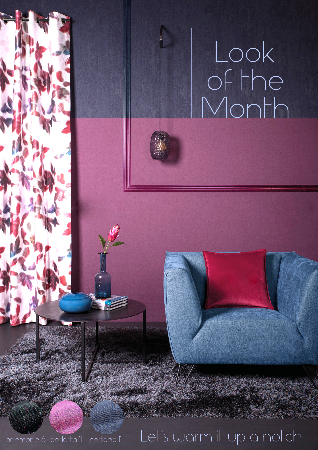
Delectable Hues: Rich Tones of Burgundy and Blue to Warm Up Your Interior Palette
Friday, November 20, 2020
Curtains Place presents a rich palette inspired by warm colour tones in the burgundy and blue range, from colours ranging from deep pink to faded shades of the ever popular purple and intense blues. Adding a warm touch to the interior, the room-high Breeze is the featured fabric in this look with wanderlust leaves in beautiful blend of these warm colours. To complement this look, intense dark hues of blue are the perfect key colour. The use of stronger and darker colours remains a strong trend in interior decoration. Here, the Arezzo collection is featured in the dark denim tone on the chair. Burgundy goes well with a range of blue shades, in particular with equally warm dark hues. The timeless tones of deep navy blue used here evoke warmth and add to the intensity. Together these colours create a cosy elegance.
Burgundy goes well with a range of blue shades, in particular with equally warm dark hues. The timeless tones of deep navy blue used here evoke warmth and add to the intensity. Together these colours create a cosy elegance.
 Styling Tips:
Styling Tips:
- Let navy blue serve as a backdrop for burgundy highlights in your room. Use an accent wall with this colour to add depth.
- Both burgundy and blue look dramatic and decadent in a luxury velvet, chenille or satin fabric. You will also find many complementing tones to combine in accessories with ranges of pinks and purples.
- For a striking curtain choice in burgundy and blue, choose collections that will work well with your theme.
- Add metallic touches to your accessories in gold if you are looking for a more classic and regal look. Antique gold finishes add a great statement to the palette.
- These colours are also great on translucent materials – vases or table tops in these tones add glam to a room.
- You can also soften down the palette with warmer shades of grey with hints of purple in it - a rug in warm grey or combined cushions for example. Alternatively, you can add these rich tones to spice up your grey interiors.
- With these warm colours keep the accessories to the minimum to avoid cluttering.
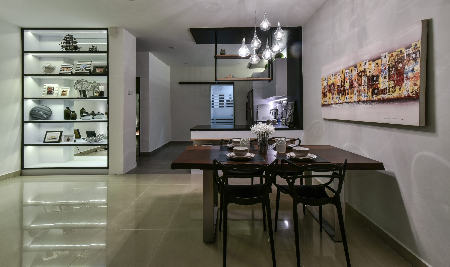
Delectable Walls: 5 Ways to Decorate Your Dining Room Walls
Friday, November 20, 2020
Decorating walls can be so much more than a mere matter of the colour of paint you apply or the school of art you subscribe to, beneath it all is a landscape of subtle considerations in terms of theme, material, and arrangement of elements. If you have the wall space to spare, consider these five ways of decorating your dining room walls to achieve effects ranging from eccentric to elegant.
1. Transposed Landscapes Interior design by: Moonlit Inspiration
Interior design by: Moonlit Inspiration
Evoking high-street galleries and art collectives of post-industrial environements, an unframed canvas introduces a contained burst of colour over a briskly white washed cement wall that serves as the background. The rectangular dimensions of the canvas are repeated in the simplistic black frame of a nearby shelving unit, while the bright display lighting and mirrored back panel contribute to the gallery ambiance.
2. Eclectic Ensemble
 Interior design by: Viincology
Interior design by: Viincology
An arrangement blending imagery evocative of England and times past: a replica of the London Underground’s roundel occupies a prominent position on the nearby wall, the field framed in warm white down-lights while a bench invitingly dotted with throw pillows underscores the arrangement. The adjacent walls host arrays of same-sized, framed motivational prints in the style of vintage advertorial flyers to add a layer of retro vibes to the eccentric décor.
3. Material Contrast
 Interior design by: Q1 Interior Concept
Interior design by: Q1 Interior Concept
The dining furniture sit at a convergence of contrasting themes: one wall bears framed images of river pebbles in their natural environment, the meditative photo prints seemingly suspended on vinyl cut-outs of birch trees. The characteristically long horizontal lines of birch bark are echoed in with reflective metallic accents lining the adjacent wall of peach-coloured stone.
4. Cohesive Display
 Interior Design by: Jashen Interior Design
Interior Design by: Jashen Interior Design
A wide field of brown on the adjacent wall adds a dimension to the monochromatic palette of the dining furniture, visually expanding the space by bridging the gap between the dark upholstery and the pale architectural finishes. An unframed abstract painting occupies the central position on the wall, its dimensions sitting neatly within the frame of the banquette arrangement.
5. Layered Presentation
 Interior design by: KP Property Design Team
Interior design by: KP Property Design Team
The glistening and colour-rich décor of this dining room is contrasted by a white wall, marked by grids with wide borders, serving as the backdrop for a monochromatic product of an ink roller and stencil. The abstract rendering and its simplistic background draw the naïve eye with the contradiction of black and white amidst a burst of colour.
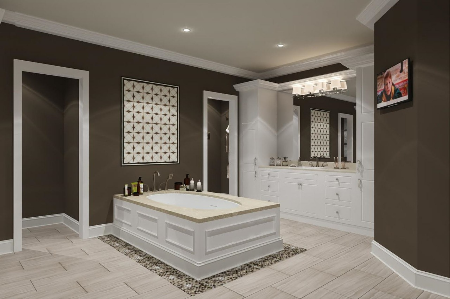
Bathe in Light: 5 Bathroom Lighting Tips to Enliven Your Bathing Space
Friday, November 20, 2020
Lighting for the bathroom is often an afterthought. It's actually important to plan it right so that you can achieve the ambience you want. These five lighting tips for the bathroom will show you how to get lighting up and running beautifully in your bathing space. 1. The Right Lighting Proper and plentiful light in the bathroom has many useful benefits. That includes setting your circadian rhythms that are an important part in over-all health, elevating one's mood, allowing bright illumination for the washing and grooming duties, and more. Most importantly is that it is critical for safety, especially for the elderly or disabled since the bathroom is where 80 percent of falls happen. 2. Minimize Glare
If you are bothered by glare, use fixtures that mask the actual light such as deeply recessed downlights or up-lights or dimmers to make adjustments as needed. Also helpful are tubular fluorescent lights with a frosted lens to reduce the glare.
2. Minimize Glare
If you are bothered by glare, use fixtures that mask the actual light such as deeply recessed downlights or up-lights or dimmers to make adjustments as needed. Also helpful are tubular fluorescent lights with a frosted lens to reduce the glare.
 3. Correct Measurements
Lighting recommended for the dressing area is eye-level provided by fixtures at least 30 inches apart with a minimum of 60 watts. That can be accomplished with chain-hung pendants or wall sconces that provide light on both sides of the face for grooming and applying cosmetics.
3. Correct Measurements
Lighting recommended for the dressing area is eye-level provided by fixtures at least 30 inches apart with a minimum of 60 watts. That can be accomplished with chain-hung pendants or wall sconces that provide light on both sides of the face for grooming and applying cosmetics.
 4. Night Lights
Night lighting is essential to safely maneuver and prevent falls in the middle of the night. Bright overhead lights can be disruptive and blinding when one's eyes are adjusted to darkness. Provide a low-wattage lamp, or one that responds to motion, or create one by illuminating the toe-space area below the vanity with a linear lighting system.
4. Night Lights
Night lighting is essential to safely maneuver and prevent falls in the middle of the night. Bright overhead lights can be disruptive and blinding when one's eyes are adjusted to darkness. Provide a low-wattage lamp, or one that responds to motion, or create one by illuminating the toe-space area below the vanity with a linear lighting system.
 5. Accentuating the Space
A decorative light fixture that is suspended from the ceiling gives any room an elegant touch at the same time that it is adding extra light.
Article courtesy of Patriot LED
5. Accentuating the Space
A decorative light fixture that is suspended from the ceiling gives any room an elegant touch at the same time that it is adding extra light.
Article courtesy of Patriot LED
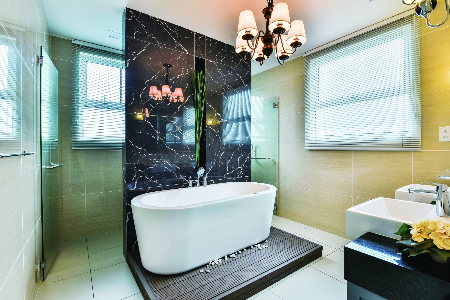
10 Ways You Can Use Tiles to Enhance Your Bathroom
Friday, November 20, 2020
If you find yourself bewildered at the range of tiles presented in your local showroom, this guide will be your rock.
Whether you are starting out with a bare cement floor, or you are faced with an aging bathroom in need of an update, there is a wide range of things that can be done with just tiles. While the default option of decking the entire bathroom in white stone may seem like the most practical choice for a clean appearance, there would be some missed opportunities for creating a unique décor in a space that most people would not expect to find a memorable interior.
 Interior design by: Nice-Style Refurbishment
Interior design by: Nice-Style Refurbishment
In pursuit of providing you with some inspiration, we took on the task of analysing the art and science of tiling: from the selection of tiles on the bases of shade, shape, texture, and size, to the installation of tiles in different orientations, arrangements, patterns, and locations. Before settling on your choice of tiles, take a look at the following ten ways of enhancing your bathroom for some ideas.
The Rule of Threes
 Interior design by: GI Design
Interior design by: GI Design
As a general rule, the formula for any balanced visual arrangement calls for a set of three elements to be used together. In the case of tiling a space as small as the average bathroom, a useful axiom to apply is to use no more than three different tiles in order to keep the arrangement from becoming overly chaotic - one for the floor, another for the walls, and a third variety for accents. As with all the other unwritten rules purporting to govern art, this guideline can be reduced for the sake of simplicity, or expanded for intricate complexity.
 Interior design by: Hoe & Yin Design Studio
Interior design by: Hoe & Yin Design Studio
Light or Dark Shade
 Interior design by: Nu Infinity
Interior design by: Nu Infinity
The shade of tiles you select contribute to either a light or dark ensemble in the bathroom, producing differing results depending on the amount of sunlight received in the space over the course of a day. Bathrooms that receive little natural light benefit from tiles in pale shades that maximise the light, while bathrooms with an abundance of sunlight are afforded the option of going darker for a more masculine result.
 Interior design by: Desenzes Interior Concept
Interior design by: Desenzes Interior Concept
Serene or Vibrant Mood
 Interior design by: The Roof Studio
Interior design by: The Roof Studio
Envision the end result you want and select tiles to achieve that end, or start with a tile you adore and build a set with complementing or contrasting tiles to suit. Either way, one should be aware of the fact that the tiles you select will go towards creating either a serene arrangement made up of complementary shades and finishes, or a vibrant assembly composed of high-definition contrasts in colour and texture.
Natural or Polished Finish
 Interior design by: Jashen Interior
Interior design by: Jashen Interior
While browsing for tiles in the ideal shade, you would have invariably come across mentions of a natural or polished finish as well. Tiles with a rough finish are appealing to purists for their natural feel, but they also serve the practical function of providing some friction for wet feet. A polished finish may entail some caution when used underfoot, but the result is an elegant and reflective surface that expands the space.
 Interior design by: M Innovative Builders
Interior design by: M Innovative Builders
Engineered Texture
 Interior design by: Architrio
Interior design by: Architrio
The repeating patterns and textures that do not appear in nature are instead machined into tiles for an eye-catching presentation - especially when used in isolated pockets highlighting functional areas of the bathroom such as the commode and shower enclosure. Tiles with high-definition textures should be used in limited amounts to keep the arrangement from appearing overly complicated.
 The relative blandness of all-white tiles can be offset by decking an adjacent plane with detailed decorative tiles for contrast, such as the monochromatic ethnic motifs presented on the bathroom floor. Interior design by: Viincology
The relative blandness of all-white tiles can be offset by decking an adjacent plane with detailed decorative tiles for contrast, such as the monochromatic ethnic motifs presented on the bathroom floor. Interior design by: Viincology
Forced Perspective
 Interior design by: Nu Infinity
Interior design by: Nu Infinity
A technique of visual composition utilised in cinematography, forced perspective entails the placement of objects reduced in scale to make nearby objects, or the space containing them, seem larger. In the context of tiling your bathroom, compact areas such as a narrow shower enclosure could be made to appear wider with the application of small tiles.
Wood Mimicry
 Interior design by: Yong Studio
Interior design by: Yong Studio
One of the most understated revolutions in architectural finishes occurred when the first tiles mimicking wood rolled off the presses. These tiles combine the warm and unique aesthetics of wood with the practicality and durability of manufactured tiles. As with tiles bearing engineered textures, these unique tiles should be used in small measures, ideally to demarcate shower or bath enclosures, so as not to overwhelm the whole assembly.
Grout Colour and Thickness
 Interior design by: Soul Frame
Interior design by: Soul Frame
A detail of tiling that often goes overlooked is grouting - the lines of sand and cement or plaster used to adhere tiles to the floor slab that visibly seep out through the gaps between tiles. As grout is typically based on plaster or ordinary Portland cement, it can be applied in varying compositions and colours. The overall appearance of your tiles can be affected by selecting a contrasting colour for clearly defined lines between tiles, or a complementary colour for subtlety - with thickness having an effect on the cohesion of the arrangement. Thick lines serve to segregate the tiles for a look best suited to country or classically inspired spaces, while thin lines integrate tiles into presentations suited for modern and minimalist interiors.
 Interior design by: IDS Interior
Interior design by: IDS Interior
Horizontal Orientation
 Interior design by: Gusto Design
Interior design by: Gusto Design
As most bathrooms are relatively small spaces, they benefit from the space-expanding effects of horizontally-oriented tiles on any plane: floor or wall. Tiles are generally sold in rectangular dimensions, making the basic grid arrangement an accessible pattern at reasonable cost.
Non-Standard Arrangements
 Interior design by: Homlux Interior Furnishing
Interior design by: Homlux Interior Furnishing
For those who find the standard grid arrangement to be too conventional, a brick pattern may bear some surprising results - even more so when laid in a bold diagonal orientation to resemble the dependable herringbone pattern. For those who open the door to look in on non-standard arrangements, they will find themselves going down a path less travelled, through a landscape of non-standard shapes and mind-bending patterns.
 Interior design by: JCS Design Project
Interior design by: JCS Design Project
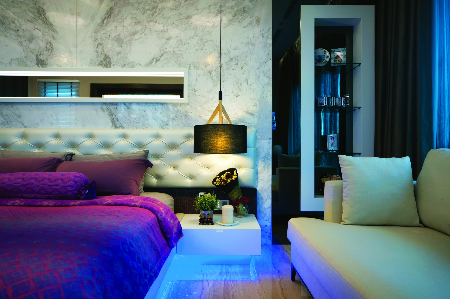
How to Make Your Bedroom Unique
Friday, November 20, 2020
While the ground floors of most homes typically exhibit the public facets of a homeowner’s personality, it is in private spaces—such as the bedroom, where the soul can truly shine unhindered by protocol and social norms.
Some might be willing to call it a day after putting in a bed, a closet, and a pair of matching bedside tables, but others may not be satisfied unless the bedroom is rendered memorable and awe-inspiring. Variety being the spice of life, we take a closer look at some intriguing bedrooms in order to outline the kind of tweaks that can set one’s bedroom apart from all others.
Levitating Platforms
Light is an understated and crucial component in visual compositions ranging from paintings to film, with its rendering being of such importance that entire careers are built around the study and application of lighting. Perhaps one of the easiest ways of differentiating a bedroom would be to add an intriguing lighting fixture and to let the wash of light paint the space in unique ways. Among the simplest and most dramatic displays of light we have encountered is demonstrated with Luna Solutions’ treatment of the pictured bedroom.
Design Spirits demonstrates this uplifting effect of lighting in combination with more opulent materials in the bedroom pictured below. Against a background of seamless marbled stone on the floors and on the walls, the designers incorporate a strip of cold blue LED lighting around the the lower lip of the bed frame and the adjoining bedside surfaces. The resulting effect is the entire bed platform appearing to float on a magical sheen that echoes the quality of daylight filtered through the blue drapery.
 Interior design by: Design Spirits
Interior design by: Design Spirits
Zen Influence
 Interior design by: Mode Interior
Interior design by: Mode Interior
In the wake of minimalism follows the pursuit of Zen aesthetics—which is essentially the effort to create serenity from simplicity. The influence of Japanese practicality and tatami flooring leads to an intriguing bed platform as designed by Mode Interior in the pictured bedroom. Applied in combination with lighting along the floor, a theme of cosmic exploration, and futuristic curves, this bedroom uniquely straddles the divide between the aesthetics of the past and the future.
Functional Partitions
 Interior design by: Luna Solutions
As Dwight “Ike” Eisenhower once said: “Plans are nothing; planning is everything.” While most of the houses on the block may feature very similarly sized spaces by way of a repeated plan, Luna Solutions renders this bedroom unique with practical space planning. A partition of carbonised steel and glass panels is raised from the wood floor of this bedroom to subdivide the space, providing adequate space for access to the bed in addition to an avenue for a walk-in wardrobe on the other side.
Interior design by: Luna Solutions
As Dwight “Ike” Eisenhower once said: “Plans are nothing; planning is everything.” While most of the houses on the block may feature very similarly sized spaces by way of a repeated plan, Luna Solutions renders this bedroom unique with practical space planning. A partition of carbonised steel and glass panels is raised from the wood floor of this bedroom to subdivide the space, providing adequate space for access to the bed in addition to an avenue for a walk-in wardrobe on the other side.
Futuristic Mode
 Mode Interior takes opulent slabs of marble and applies them in angular cuts to the wall of the pictured bedroom, backlighting the panels with hidden sources of illumination to create a decorative feature that seemingly draws inspiration from designs portrayed in science fiction. Interior design by: Mode Interior Style
Mode Interior takes opulent slabs of marble and applies them in angular cuts to the wall of the pictured bedroom, backlighting the panels with hidden sources of illumination to create a decorative feature that seemingly draws inspiration from designs portrayed in science fiction. Interior design by: Mode Interior Style
The attraction of following within the confines of known decorative styles is a result that is instantly recognisable and attributable to a particular school of aesthetics: classicism denotes opulent formality, while minimalism entails functional simplicity. Aside from experimenting with blends of defined styles, one other route of differentiation would be to take the avant-garde approach in the bedroom—to paraphrase the words of some fictional spacefarers—to boldly go where no one else has gone before.
 A partition and television wall composed of white marble rises from the floor, containing the bed within a comforting berth of stone.
[gallery columns="2" size="medium" ids="58326,58327"]
A partition and television wall composed of white marble rises from the floor, containing the bed within a comforting berth of stone.
[gallery columns="2" size="medium" ids="58326,58327"]
The futuristic theme is extended to the workstation on the other side of the partition, with slats running along the ceiling—an acoustic and thermal consideration shaped in the manner of a ship’s ribbing.

7 Ways to Make Your Living Room Unique
Friday, November 20, 2020
Great minds may think alike but few actually enjoy being the unwitting character in the trope of two party guests dressed the same. If you’ve ever experienced a disorientating wash of déjà vu when stepping into someone else’s living room, you may be interested in finding ways of differentiating your own space. In this guide, we take a look at the various avenues for creating uniqueness in your seating lounge.
Feature Walls
 Interior design by: GDY Design
Interior design by: GDY Design
Unless every piece of furniture is individually manufactured to your specific tastes, there’s a chance that the arrangement of your living room is similarly, if not identically, represented in someone else’s home. To differentiate the pictured seating lounge, GDY Design & Construction apply their creative impulses to the surrounding walls by relying only on a monochromatic palette and a simplistic brick motif. With the walls rendered unique, their efforts encapsulate the furniture arrangement in an environment that could only be duplicated with access to the designer's schematics.
High Ceilings
 Interior design by: Desigva Interior
Interior design by: Desigva Interior
Just as the oculus—the circular skylight at the apex of the Pantheon’s dome in Rome—has provided pilgrims and curious sightseers with spiritual experiences for over a millennium, an extra-height ceiling or an air-well appointed with generous windows and skylights will create entry points for sunlight. As the quality of sunlight varies over the course of the day, the tones of the pictured seating lounge are highlighted in various unique ways: the warm and ethereal light of sunrise and sunset accentuates the darker colours, while the brightness of midday emphasises the white background.
Aquascaping
 Interior design by: ID Industries
Interior design by: ID Industries
Beyond being an element of favourable geomancy (feng shui), an aquarium in the seating lounge is another dimension of decoration that can be altered over time much like a garden on dry land. ID Industries, the designers of the pictured living room, tactfully include a lush planted aquarium into a space dominated by grains of wood. This unique decorative feature extends the organic theme of the space, while simultaneously acting as a physical barrier in the open layout and providing a source of soft lighting that ripples with movements in the water.
Customised Shelving
 Interior design by: Shirley Yeong via Beata Home and Office Furniture
Interior design by: Shirley Yeong via Beata Home and Office Furniture
Slabs of marble are never identical, even when comparing two sequential cuts from the same rock face of the same quarry. Getting shelves made to specifications is perhaps one of the most common methods of differentiating a space, and opting for shelves made from marble adds a layer of uniqueness with the highly variable shades and veining patterns typical of most marbled stone. In the seating lounge pictured above, the customised marble display surfaces are combined with gilded accents, mirrored panels, and darkly stained wood to create a palatial space fit for royalty.
Floor Displays
 Interior design by: Mode Interior Style
Interior design by: Mode Interior Style
Where most would opt for a uniform expanse of seamless stone on the floors, an artistic display deliberately laid beneath one’s feet provides a surprising point of intrigue in the seating lounge. In the pictured living room decorated by Mode Interior Style, a Zen-inspired display of white river pebbles is contained within a raised dais of wood to demarcate the space and provide the naïve eye with an additional decorative feature to linger upon.
Musical Instruments
 Interior design by: Latitude Design
Interior design by: Latitude Design
Whether it is a museum piece or a more contemporary instrument made affordable by mass manufacturing, a musical instrument provides the potential for creative expression and draws attention in the same way that an unfinished painting in a gallery of finished works invites intrigue. The classically inspired décor of the pictured home is complemented by a ubiquitous grand piano of modern origin, but the auditory sensations that this instrument could produce render the space unique with the anticipation of a musical experience.
Dramatic Lighting
 Interior design by: Design Base
Interior design by: Design Base
Just as sunlight affects a space in highly varied ways through the day, artificial sources of light can also serve to accentuate colours and paint a living room in unique tones. As demonstrated by Design Base in the living room pictured above, a refined and carefully curated blend of architectural finishes, decorative features, and lighting result in a space that will not easily duplicated elsewhere. In this seating lounge, sheer curtains filter the sunlight to complement the pale wood floor, the white walls, and the ultraviolet tone of light emitted from concealed sources in the ceiling tray and around the feature wall.
Read a similar article in Mandarin here.
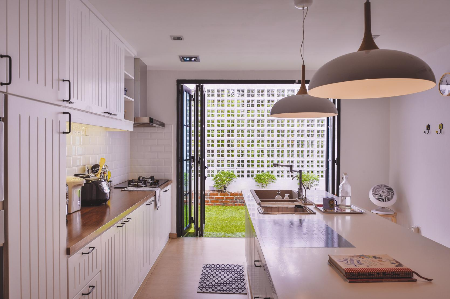
Renovations to Raise the Comfort of Terraced Homes
Friday, November 20, 2020
The terraced home is the traditional starting point for most new families: they provide driveway space for at least one family vehicle, yard space for partaking in cottage industries, and are relatively inexpensive grounded properties—having been constructed en masse from easily repeatable designs. But the root design came about as a solution to an industrial-era problem: the innovation of shared walls provided homeowners in colder climates with the benefit of reduced heating costs, and this feature of terraced homes works to our disadvantage in the tropics. As any who has lived in one would be able to point out: conventional terraced homes seem somewhat unsuitable for our hot and humid weather—an assertion that becomes obvious when air conditioning is needed to render the temperature indoors liveable during the day. In this guide, we take a look at the various tweaks that appear in renovated terraced homes and explore their effects on comfort levels within the interior.
Cooling Materials
 Interior design by: Yong Studio
Interior design by: Yong Studio
Bare concrete is quite adept at retaining heat, more so than brick, and even more than wood—which is why concrete or brick walls are covered with paint or plaster, and even wood is often whitewashed. White surfaces reflect light and consequently retain less heat, but more can be done to cool the interior via the informed selection of materials. In this terraced home renovated by Yong Studio, bare walls are painted white, glossy white tiles are used for the backsplash, white perforated bricks make up the outer perimeter wall, while the floors and countertops are rendered in wood. The wood surfaces do more than brick or concrete to cool interiors without the added advantage of a white coating—the capacity of most varieties of wood to retain and transfer heat is typically a fraction of that for brick or concrete.
 The perforated bricks of the outer perimeter wall reflect light and heat, while allowing the occasional gust of wind to pass through and cool the home from the exterior. Interior design by: Yong Studio
The perforated bricks of the outer perimeter wall reflect light and heat, while allowing the occasional gust of wind to pass through and cool the home from the exterior. Interior design by: Yong Studio
Extended Roofing
 Interior design by: Yong Studio
Interior design by: Yong Studio
Due in part to their lightweight construction, most terraced homes do not typically come with generously cantilevered roofs—leaving modern window panes to catch the brunt of sunlight during the day and radiate that heat into the interior to stifling effect. This characteristic of terraced houses prompts homeowners to add awnings or extend roofs to provide additional shade for the windows below. But while polycarbonate and glass sheets tend to be relatively affordable and uncomplicated to install, these materials are translucent and may do little to beat the heat unless tinted. A full-fledged concrete slab is a more costly alternative, but it provides cooling shade for the windows below—with the added benefit of additional floor space on the upper level.
 Interior design by: Space In Design
Interior design by: Space In Design
Ventilated Roofing
 Interior design by: Surface R
Interior design by: Surface R
The draw of Minangkabau-styled roofs extends beyond the intriguing concave-curved eaves—the traditional roofing design entails air vents in the soffits, which allow hot air to rise up the walls and into the voids beneath the shingles. An observant builder noticed the tendency for hot air to rise and this ancient knowledge enabled people to live comfortably in the tropics, even without the benefit of mechanical air circulation. With this principle in hand, modern roofs can be retrofitted with vents to allow hot air to naturally rise upwards, leaving the floors of the lower levels cool to the touch.
[gallery columns="2" size="medium" ids="58240,58241"]Vaulted Ceilings
 Interior design by: Archicentre
Interior design by: Archicentre
The standard response to an exposed concrete slab overhead is to cover it with a suspended plaster ceiling to provide a uniform surface, but the extra headroom would then be wasted instead of acting as a heat-sink. Just as wine cellars of tradition featured vaulted ceilings to trap and funnel hot air, so do modern homes with ceilings that bear exposed beams. If industrial aesthetics are not quite your bag, the same effect can be achieved with more conforming architectural finishes—as Q1 Interior Concept demonstrates in the home pictured below.
 Interior design by: Q1 Interior Concept
Interior design by: Q1 Interior Concept
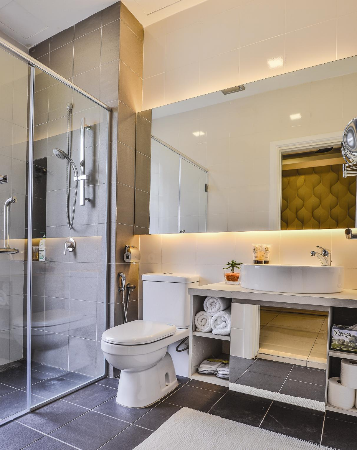
How to Choose Your Bath Tub and Shower Stall
Friday, November 20, 2020
Shower, bathtub, or both - we take a look at the complete range of possibilities for your bathroom.
 Interior design by: Desigva Interior
Interior design by: Desigva Interior
Despite the multitude of characteristics that separate us in terms of personality, creed, or ideology, we all tend to live our lives in very similar ways - the experience of starting and ending each day being similar for most people, albeit with some finding it easier to endure than others. Most of us probably find ourselves in our bathrooms at the start and end of each day, but the subtle effects of our fixtures on the experience of opening or closing a big day often go unnoticed.
 Interior design by: Nu Infinity
Interior design by: Nu Infinity
While having the most spartan of fixtures to satisfy the most basic of needs is adequate for civilized life, we believe that a full life is not lived without at least a decent shower or a bathtub. To help you sort through the multitude of options available, we analysed the landscape of bathtub and shower stall designs to bring you the following guide.
Drop in Bathtubs
 Interior design by: Beverly Home
Interior design by: Beverly Home
Where bathtubs in alcoves make for a comforting sanctuary, the drop-in variety of tubs are intended to take advantage of breathtaking views and do not require the addition of walls, with slightly higher skirted rims to reduce splashing. Drop-in tubs require similar attention to architectural detailing as alcove tubs, on account of their commonly lacking finished sides and requiring a built- up section of the bathroom to fit into. Some variations of drop-in tubs are equipped with shower heads, requiring configurations where one side rests against a wall, while other designs without a shower head may be placed centrally - with the necessary pipe connections embedded in the floor.
Corner Bathtubs
 Interior design by: Q1 Interior Concept
Interior design by: Q1 Interior Concept
Typically available in both drop-in and freestanding designs, corner tubs provide the option of a soak in a luxurious orientation with a space-saving design that fits into corners only slightly larger than the space required for wall-hugging varieties. The more opulent designs of the corner tub are made for two, with some varieties equipped with whirlpool nozzles for a spa experience or a surface to act as an impromptu shower bench. As corner tubs are typically low- profile and ideal for uninterrupted views, the option of a shower occurring within the same footprint is more of a rarity - requiring the installation of separate inlet piping to connect with a shower head.
Freestanding Bathtubs
 Interior design by: Nu Infinity
Interior design by: Nu Infinity
The freestanding variety of bathtub is reminiscent of tubs before the age of indoor plumbing - paradoxically, it is also the most common design of bathtub being sold out of any modern bathroom fixture store. The freestanding tub is typically made with a curved rim; it is completely finished and sloping on all sides, making it ideal for central placement in a broad space without the addition of any architectural detailing. However, the lack of structural support provided by enclosing walls entails a greater degree of consideration in ensuring sturdy placement to preserve the integrity of pipe connections.
[gallery size="medium" columns="2" ids="57545,57546"]Prefabricated Enclosures
 Interior design by: Design Spirits
Interior design by: Design Spirits
Getting a completely prefabricated shower stall is the simplest way of segregating wet areas from dry areas and providing the most compact showers in the smallest of bathrooms. Prefabricated shower enclosures consist of a floor tray connected to surrounding walls and a sliding or folding door - all typically composed of affordable plastics. The most space-efficient designs are made to fit into corners, with more extravagant versions fielding rounded corners and curved sliding doors.
Customised Enclosures
 Interior design by: IDS Interior
Interior design by: IDS Interior
While prefabricated enclosures are the preferred solution for bathrooms in high-rises, those with a creative streak and space to spare may be afforded with the option of customizing their own shower enclosures. The most common configuration of shower enclosures in landed properties consist of a tiled floor constructed in combination with a wide variety of opaque or transparent materials for walls and doors. A shower stall can be built up to fit a space of standard dimensions, but a space with unique proportions may require frames and panels for walls and doors specially made to measure.
Basic Showers
 Interior design by: Yong Studio
Interior design by: Yong Studio
The simplest shower - and likely the first to be encountered in any new property, consists of a shower head attached to an inlet pipe embedded in the bathroom wall. The consideration of segregating wet and dry areas in the bathroom is lacking, but a shower can be had without any frills or additional expenditure - however, the downside of keeping to the configuration that came with your property is a perpetually wet bathroom floor that requires daily housekeeping.
Classic Bathtubs
 Interior design by: Gusto Design & Build
Interior design by: Gusto Design & Build
Although quick showers require far less water, nothing provides an intimate and indulgent experience quite like soaking in a tub. The most prevalent form of bathtub is equipped with a shower head to provide the option of showering in the same footprint, and designed with a skirted edge around the rim to fit over architectural finishes. Building up walls around the exposed sides of an alcove bathtub prevents splashes from wetting the rest of the bathroom and creates a cosy grotto that enables placement of the tub against a wall to occupy a space similarly required of built-up shower enclosures.
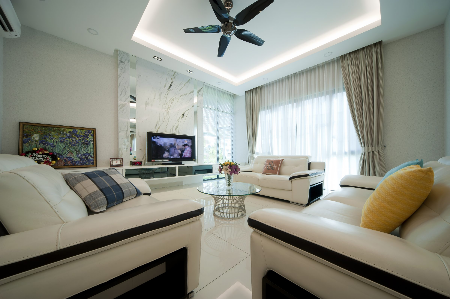
Decorating for Elegance with Versatile White
Friday, November 20, 2020
Whether the reasons are grounded in physics, biology, or culture, the colour white represents purity for most people — and as demonstrated by Isaac Newton and the album art for Pink Floyd’s Dark Side of the Moon — white is perhaps the most adaptable of colours, being composed of all the other hues of visible light. Given the association of white with purity, and our common understanding as to what makes the colour so universally compatible with other hues, many choose it as the predominant shade of our homes. In our attempt to explore the various effects of colour, we take a closer look at a range of spaces that have been saturated in white.
Living Room

Where one would normally imagine a space monotonously saturated in white, the quality of white in this seating lounge is instead made intriguingly varied with a range of whites applied — from the pristine plaster ceilings, largely unadorned and untouched walls, to the subtly cream floor tiles. A few choice accents appoint the space to add variability to the range of shades while being emphasised by the pale background: a panel of white marble flanked by reflective metals adds a shimmering layer of luxury and a few playfully coloured throw cushions provide some mirth.
 The reliance on white provides visual emphasis and brings attention to the few coloured decorations and reflective finishes in this space.
The reliance on white provides visual emphasis and brings attention to the few coloured decorations and reflective finishes in this space.
Dining Room

The use of off-white upholstery and subtly pinstriped curtains against the pale background of this space elegantly contains the black glass and steel dining table against the sheer-covered windows and cream floor tiles. The resulting visual illusion diminishes the presence of the dining surface, making the arrangement appear to blend with the surroundings in an effort to preserve empty floor space. As with the seating lounge, a coloured element in the form of a blooming stem of purple orchid placed in a turquoise and brown glass vase takes advantage of the white background to create its own emphasis and to provide the space with a visual breath of fresh air.
Kitchen

The majority of modern kitchens are rendered almost entirely in white for the sake of maintaining an immaculate appearance. This common practice also creates a versatile background that will accommodate and complement appliances in a range of colours and finishes — so you don't necessarily have to hunt down appliances that match each other. The pictured kitchen exhibits a classically inspired décor that is largely unaffected by the array of modern appliances, due in part to the white of the background lending itself well in combination with other colours,
Bedroom

The use of white in bedrooms more often than not results in an overtly feminine space, especially when combined with intricate wall coverings, sheer curtains, and classical details such as a capitonné leather headboard. The pictured bedroom arrangement utilises white less as a background and more as an accent colour, but the prevailing theme and underlying principles are the same — the application of white brings together the disparate hues of the space.
Interior decoration by: Latitude Design. Read a similar article in Mandarin here, more about this home here, or about decorating with blue and grey here.

A Modern Raya at Home: Decorating Tips
Friday, November 20, 2020
The search for seasonal trappings ramps up to a fever pitch as we approach the end of Ramadan and prepare for the highly anticipated Aidilfitri (Eid al-Fitr) celebrations to follow. With little more than a week to assemble the necessary decorations, appliances, and accessories of the season, we prepared this guide to get you ahead of the curve and provide some decorating ideas to get your home ready for the big feast to come.
Customary Colours
The first item on your list of things to do would likely have something to do with injecting the colours of the season into your banquet space. While the favoured colour of tradition would be a familiar range of green shades, paint manufacturers such as Dulux recommend pushing the line of convention a little further with the application of alternate colours to complement dashes of green. Dulux’ 2018 Colour Futures (the annual palette of trending colours) contains a range of muted and soft hues, including Heartwood (Dulux’s designated colour of the year), to complement various shades of green. For those looking to craft a luxurious ambiance, Dulux suggests using a range of paint with some shimmer to it - and it just so happens that they’re giving away coffee and food vouchers with purchases of paint from the AmbianceTM Pearl Glo range.
Symbolic Motifs
 Image Credit: Nala Designs
Image Credit: Nala Designs
Malaysian batik and textiles adorned with the floral, abstract, or geometric motifs make for striking clothing, but they could also be used as a form of ad-hoc decoration in Aidilfitri-themed interiors. These fabrics could take the place of curtains, or they could simply be draped over furniture to provide layers of complexity in the theme of the season. Alternatively, if you find the colours and patterns of a piece of fabric particularly appealing, you could also transpose them to walls in the form of wallpaper or paint.
Classical Décor

With the entire extended family set to visit, you might be planning on setting up an exquisite décor to awe your guests - and with that in mind, we highly recommend looking to classical furniture and accessories such as those provided by The Home Concept Furniture. The timeless quality of classically inspired furniture and decoration has been a mainstay of Malaysian interiors for as long as classical style has been synonymous with prosperity, making this school of aesthetics ideal for portraying a flourishing household.
Essential Equipment
 Image Credit: Panasonic
Image Credit: Panasonic
As it goes without saying that food takes on a central role in our daily lives, a banquet table during Aidilfitri would be incomplete without a simmering pot of rendang. If you are hosting a large gathering, or if you simply want to keep the requisite dishes piping hot until the celebration draws to a close, you should consider getting yourself a crock pot - such as the pictured five-litre slow cooker from Panasonic. Just as with chocolate fountains, the presence of a steadily boiling crock pot among a series of buffet chafer sets will be an attraction on its own.
Seductive Servingware
 Image Credit: Vantage
Image Credit: Vantage
Beyond being a concern of protocol, making some formal dinnerware available on the banquet table immediately elevates a feast to luxurious heights. For a layer of elegance, consider adding classically inspired platters in white and gold - such as the pictured servingware set from Vantage, or solidly coloured plates and bowls to casually echo the hues of the space.





